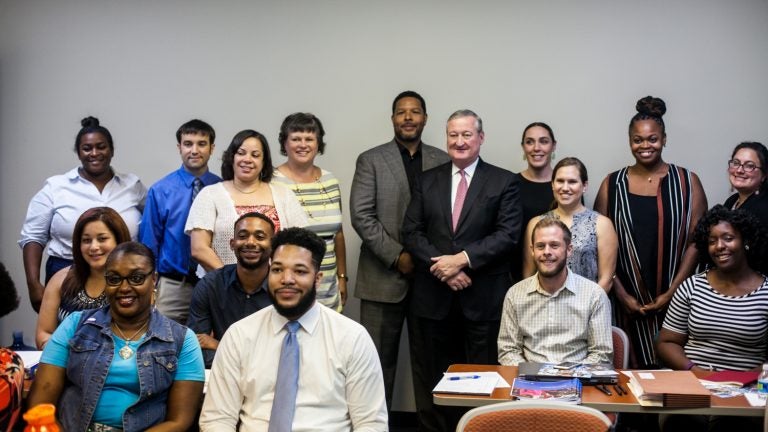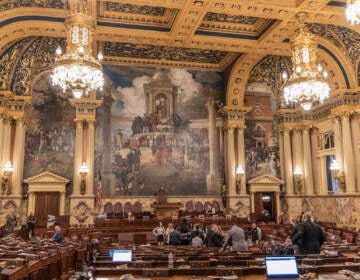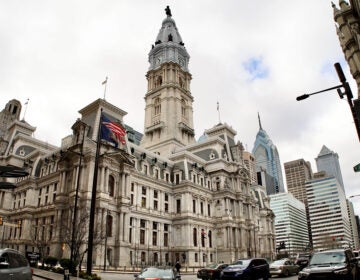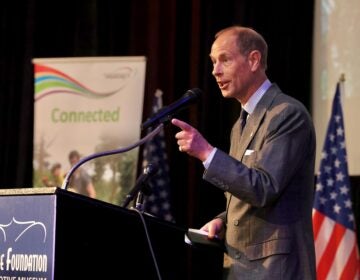Relations between city, district cause growing pains for community schools
The 100-page report says city and school officials haven’t worked well enough together to ensure the program's success.

Mayor Jim Kenney poses with staff from community schools. (Brad Larrison for WHYY, file)
This story originally appeared on PlanPhilly.
—
When Philadelphia designated nine community schools in 2016, officials didn’t announce any numeric goals for the high-profile initiative funded with revenue from Mayor Jim Kenney’s controversial tax on sweetened beverages. They did, however, promise an outside evaluation.
That evaluation came down Thursday — 100 pages of analysis that suggest some success in the first year of the project and some high-level issues that need to be addressed.
The positives came mostly at the school level, where analysts from the nonprofit Research for Action found high buy-in from principals and promising inroads made by community school coordinators.
Big picture, though, the report’s authors worry city and school district officials haven’t worked well enough together to ensure the success of the ambitious programs meant to help students overcome barriers associated with poverty. Research for Action analysts urge the project’s leaders to develop clearer goals that can be measured and tracked.
“A strong relationship at the highest levels of the Mayor’s Office of Education and the School District of Philadelphia did not develop during the first two years of the initiative,” according to the report.
That relationship has improved notably this year, officials said in response to the report, and they’re working together on a new plan that will better define how they measure success.
“It’s not something where you just hop on a tandem bike and everyone is just pedaling together right away,” said Otis Hackney, who heads the Mayor’s Office of Education, known as MOE. “We had to go through a little bit of growing pains.”
Research for Action analysts said that’s natural for a project as new and complicated as community schools.
“These are really difficult initiatives to pull off,” said Kate Shaw, Research for Action’s executive direction.
The community school model takes an existing public school and turns it into a neighborhood hub, a place that welcomes outsiders and provides services to help students and their families address some of the non-academic difficulties that can hamper educational efforts.That could mean job training for parents; a food pantry for hungry students; eye exams to make sure kids can see the board; or anything else community members dream up.
Kenney initially wanted to create 25 community schools, mostly funded through Philadelphia’s new soda tax. He’s since scaled back the goal to 20 schools after the city pulled in less tax money than expected.
Each community school has a coordinator tasked with gauging what the neighborhood wants and finding some way to provide it. So far there are 12 of those coordinators, one in each of the nine schools named in the first cohort and three in the trio of schools added since.
The Research for Action report gives high marks to those coordinators.
“The strengths of the initiative lie, most notably, at the school building level,” researchers wrote. “Through additional capacity in the form of coordinators, MOE became a catalyst for integrating social support for students, families, and community members.”
The report found coordinators worked well with administrators and teachers, integrating themselves into school communities with relatively little trouble.
“School staff were saying they had their coordinators’ cell phone numbers and would text them on a regular basis,” said Mark Duffy, the report’s co-author.
Coordinators did report some trouble earning the trust of community members, with one saying it was “like pulling teeth.” But overall, the report noted real enthusiasm and progress at the building level.
A call for better coordination
To sustain the initiative over the long term, though, Research for Action said different branches of local government need to coordinate better. The city and school district have historically kept their administrative distance, particularly under the 17-year reign of the state-controlled School Reform Commission.
The city recently reclaimed control of Philadelphia’s public schools, and many hope it will lead to a better relationship. This summer, high-level city and district leaders sat down to map out a new roadmap or “logic model” for the community schools initiative.
“I think we are rowing in the same direction,” said Karyn Lynch, the district’s chief of student support services.
Perhaps the biggest knock in the report comes in the area of measurement and evaluation. Researchers found community schools didn’t have specific outcomes in mind and didn’t collect data to monitor their progress.
“To measure the impact of the community schools initiative, it is essential to identify outcomes and the measures that will be used to determine progress,” the report’s authors wrote.
While leaders did identify some targets, the report said, those targets were “broad” and “did not include specific measures to track progress.”
From the get-go, city leaders shied away from using test scores, graduation rates, or other traditional academic metrics to determine whether the model works.
They have said they’d like to eventually use attendance rates as a “long-term” measuring stick for the program’s success, and will look at those figures five years into the initiative. The Research for Action report noted, however, that in other cities with community schools, attendance trends improved within three years.
WHYY is your source for fact-based, in-depth journalism and information. As a nonprofit organization, we rely on financial support from readers like you. Please give today.





